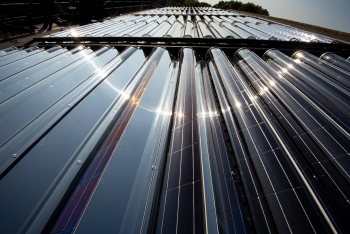Solar thermal is technology that captures the sun’s energy for heating purposes, such as water heating, industrial processes, and space heating. It uses a thermal absorber to capture and convert the sunlight’s energy to thermal energy. The different types of solar thermal technologies include:
- Flat Plate Collectors (FPCs): Common for domestic hot water generation.
- Evacuated Tube Collectors (ETCs): Suitable for higher temperatures for space heating and industrial processes.
- Concentrating Solar Thermal Power (CSP): Utilises mirrors/lenses to reach temperatures up to 1500°C, ideal for electricity generation and district heating.
Working Principle of Solar Thermal
- Absorption of sunlight: Evacuated tube collectors absorb sunlight to heat a fluid, typically water.
- Heat transfer: Heated fluid is used directly or transferred to a heat storage.
- Heat storage: Stored fluid allows operation during low solar irradiance.
Solar Heat Technology Common Applications
- Commercial water heating: Supplements conventional water heaters systems.
- Space heating: Supplements conventional heating systems.
- Industrial processes: Provides high-temperature heat for various processes.
- Electrical generation: Uses concentrated heat to drive steam turbines or direct drive power cycles.
Solar Thermal Advantages
- Abundance of solar energy taps into renewable solar energy.
- Renewable: Zero emissions, very low environmental impact.
- High efficiency: FPCs and ETCs are generally more efficient than PV. For very high temperatures CSP is the most efficient technology.
- Low maintenance: Cost effective over lifespan.
- Scalability: Applicable to various scales and thermal demand needs.
Solar Thermal Technology Challenges
- Intermittency: Requires storage or backup systems.
- Initial investment: High upfront cost.
- Location dependency: Sunlight availability varies by location.
- Storage limitations: Capacity can restrict scope of installation.
Conclusion
Despite its challenges, solar thermal is a key technology available today to significantly reduce carbon emissions. The IEA predicts solar thermal systems will be used in 30% of buildings by 2050. Undoubtedly, solar thermal technology holds promise for a sustainable energy future and is expected to play a significant role in the energy transition as the technology advances further and cost-effectiveness improves.
Find out more about Virtu solar thermal https://www.rinnai-uk.co.uk/products/commercial/solar-collectors
What makes the solar thermal evacuated tube solar collector system supplied by Rinnai unique?
- VirtuHOT (solar thermal) and VirtuPVT (photovoltaic and solar thermal) are Naked Energy’s two core products. VirtuHOT generates heat up to 120°C while VirtuPVT generates heat up to 75°C.
- They are engineered to provide the highest energy density on flat roofs. Naked Energy’s solar collectors produce between 50-100% more energy per square meter of available roof area.
- It is estimated that conventional PV (photovoltaic) technology - the solar panels seen on many homes - needs up to three times more space than Naked Energy’s VirtuHOT and VirtuPVT products to capture the same amount of energy.
Virtu product range USPs
Lower installation and maintenance costs:
- A design-led architecture and turnkey solution makes Virtu products easy to install.
- Low-profile design reduces wind shear and the need for ballast or roof penetration.
- Remote monitoring platform for performance analytics and preventative maintenance.
- Low maintenance and backed by a 10-years warranty.
More versatile:
- Virtu has exceptional performance on flat roofs and can also be deployed on sloped roofs and vertical façades.
- Low profile and tubular design avoid wasted space and inter-row shading.
- Integrated reflectors boost peak performance by 40%
- Solar thermal evacuated tube collectors have four orientation settings, optimising performance on pitched roofs, flat roofs and vertical façades.
- The vacuum tube minimises thermal losses to the atmosphere, resulting in high efficiency even in cold weather.
- Can deliver high temperatures up to 120°C and is certified to withstand stagnation at up to 240°C, so is suitable for both domestic hot water in residential and commercial buildings, and low temperature process heat.
- Utilising renewable energy improves building ratings and supports the transition to a zero-carbon economy.
Up to 50% greater financial returns per square metre
- Virtu is designed to maximise the solar potential of a building's roof.
- Reduces energy bills and provides security against energy price inflation.
- Eligible for many governments subsidies.
We recognise that air source heat pump design is not a straightforward task especially when designing commercial heat pump systems, so we aim to take the pain out of the process with our design support, capital expenditure, operational expenditure and carbon modelling for a free consultation with our heat pump experts contact us today on 0300 373 0660 or Help me choose a product :: Rinnai UK (rinnai-uk.co.uk)
Useful resources
Advice on installing solar water heating - Energy Saving Trust

